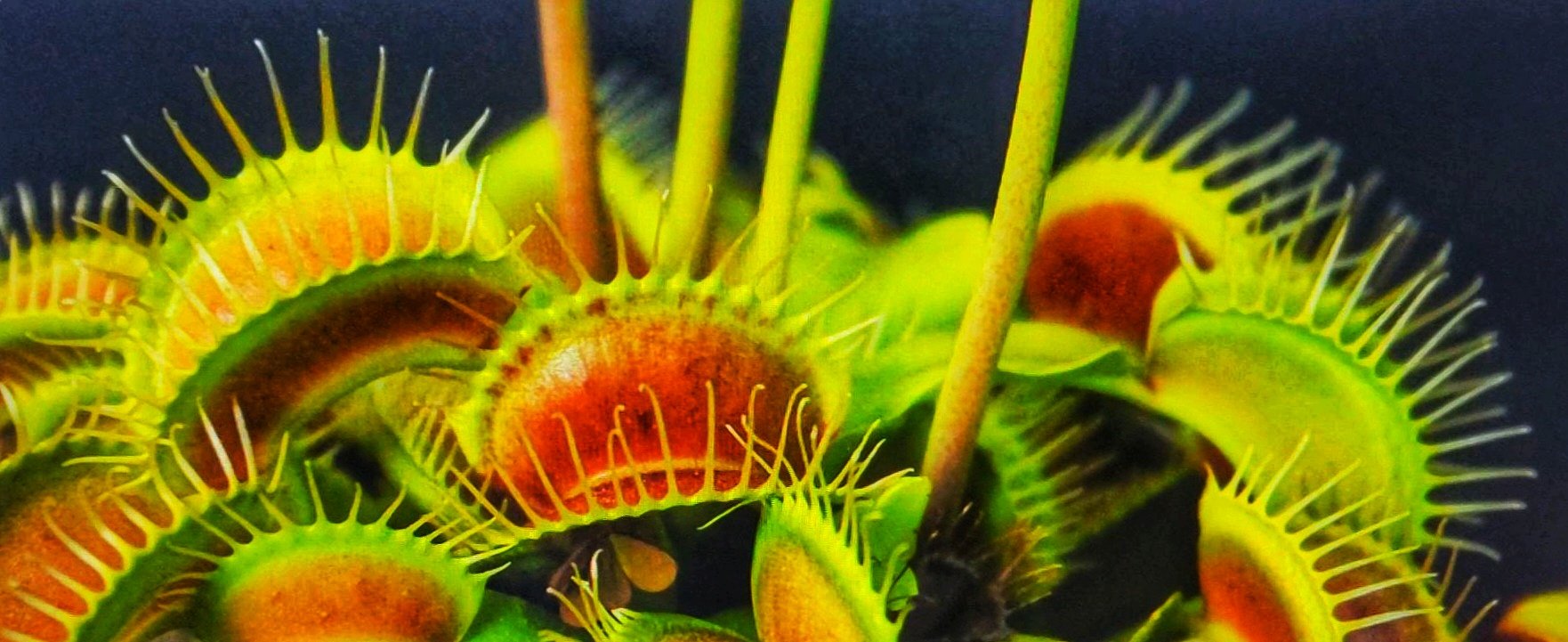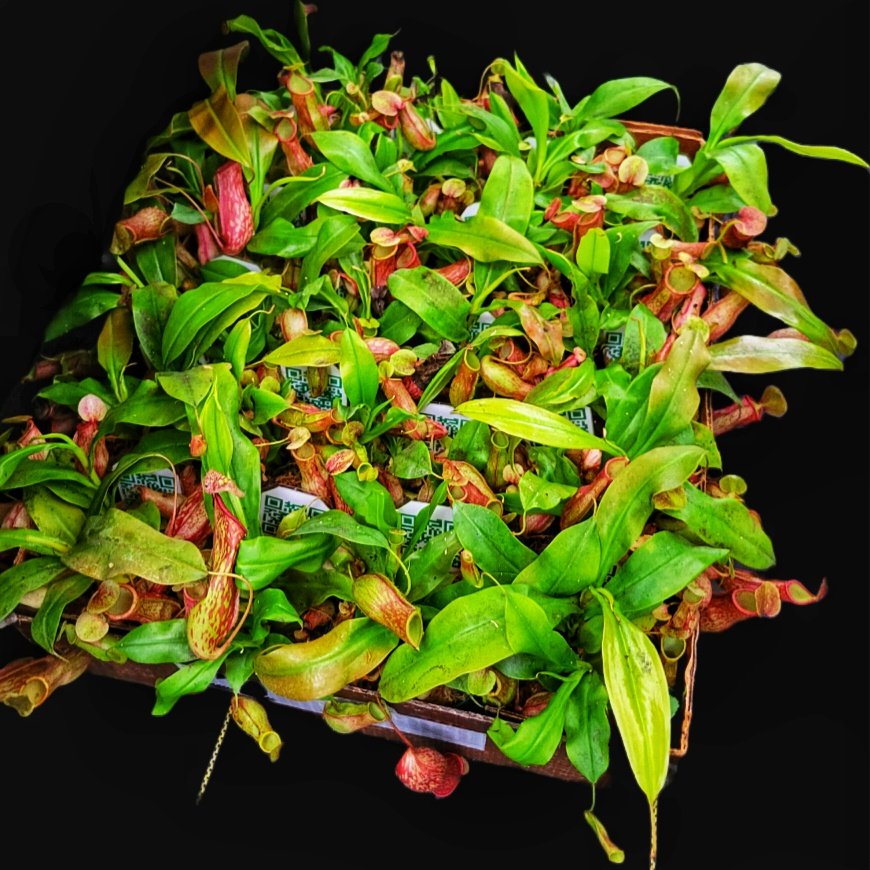CARNIVORES
Nepenthes ‘Miranda’ (N. maxima and N. northiana)
Carnivorous plants are a wonderfully diverse group of plants encompassing many different genera and species. Hailing from a variety of climates, they all have their own unique growing needs- but there are a few universal rules to successfully grow most carnivores.
WATERING & SOIL
Carnivorous plants, with some exceptions, require plenty of water- often completely saturated soils. The majority of carnivorous plants come from wetlands or bog environments, where the soil remains wet year round. For example, two of North Carolina’s native species- the Venus Flytrap (Dionaea muscipula) and Purple Pitcher plant (Sarracenia purpurea)- both come from the boggy floodplains of the east coast. Here, the soil remains constantly wet during the growing season and often floods. This works well for them, as environments with standing water also means higher insect populations for them to consume.
Translating this to growing carnivores at home, it is best to grow your carnivorous plants in soil that holds a lot of water. Heavily peat based soils are often used, as well as long fiber sphagnum moss. This makes sense as live sphagnum moss is often found thriving alongside carnivorous plants in boggy areas. Our personal favorite carnivore soil is Besgrow Spagmoss- this brand of long fiber sphagnum is far superior to other brands. Use it alone or amend it with course perlite or pinebark, depending on species.
To ensure your carnivore never dries out, it is recommended to keep your plant in a shallow tray filled with water.
FERTILIZING
In the wild, most carnivores grow in nutrient desolate soils. The ability to consume nitrogen and other nutrients from insects is what allows these species to capitalize in areas most other plants cannot. This also means carnivorous plants require very clean water and soil. They do NOT tolerate any buildup of minerals or chemicals from tap water, so it is best to use rain or distilled water if possible. Tap water can be used, but occasionally flushing the soil by flooding it with clean water will help. Further, NEVER FERTILIZE a carnivorous plant- is is unnecessary and will likely kill your plant.
The bottom line for most any carnivorous plant can be summarized as: water frequently with purified water, and never fertilize. The specific requirements of species grown and sold here at Tabula Rasa are explained below.
VENUS FLYTRAP
When you think of carnivorous plants, no doubt the Venus Flytrap is the first to come to mind. Native to North Carolina, these bog plants are intrinsically captivating with their mouth shaped leaf traps. Inside each trap are three sensory hairs that when touched, signal to the plant to close and capture its prey. To see one in action, take a small stem and trigger two of the ‘hairs’ inside the trap at the same time and watch how quickly they close.
Because flytraps are native to North Carolina, they can be planted outside into your landscape and left there year-round. In fact, they are a temperate species- meaning they require a cold dormancy and will actually perform best outside. This also gives them the opportunity to flower, seed, and propagate themselves too. When planting them into your landscape, select a very sunny spot with moist soil- around the edges of ponds or a drain ditch is ideal.
Even though they do best outside, they can successfully be grown in greenhouses or in your home too. After several years of no winter dormancy however, they may eventually die. Otherwise the same care applies- moist soil, bright sun from a south facing window, and clean water. If you grow them in a location where they have no access to insects, you can occasionally feed one or two of their traps a fly or similar insect. Do this sparingly- they do not need all of their traps constantly fed.
Nepenthes ‘St Gaya’
NEPENTHES
Nepenthes are our all time favorite carnivore to grow as houseplants. They are true tropicals, native to South East Asia, Australia, India, and Madagascar- meaning they will thrive in the ambient temperatures of your home. In our greenhouse, they are one of the most effective carnivores- their traps are always filled with digested insects like wasps and flies.
Because they are a climbing/vining species, we recommend planting them in hanging baskets to allow them to spread. This helps give their new pitchers space to open and orient themselves in a way that prevents them from being spilled. If the fully formed traps spill or do not have any fluid in them, pour a little distilled water in the pitcher to prevent them from browning.
Being understory plants, often growing on the limbs of trees, Nepenthes do best in bright indirect light such as an eastern facing window. If the leaves begin turning a blushed red color this indicates you may have them in too much sun. If your plant makes little to no new pitchers, or the leaves begin to yellow, it is likely that it needs more sun.
Some species of Nepenthes, like N. alata, are tolerant of lower humidity levels. However, almost all nepenthes will benefit from higher air humidity, growing faster and producing more traps. In your home, this can be accomplished by misting the foliage daily, investing in a humidifier, or keeping the plants on a shallow tray of pebbles filled with water.
If your Nepenthes is in a place where it doesn’t have access to insects like flies, gnats, wasps, or ants, they can benefit from occasionally dropping one into the mature pitchers. It is not necessary to feed them in excess, sparingly is best.
SARRACENIA
North Carolina is home to seven species of Sarracenia, or temperate pitcher plants. S. flava and S. purpurea are the most common in our part of the state, with S. purpurea being our personal favorite- large, squat burgundy traps that often dual as a home for small frogs. S. flava is also beautiful, with much taller, more narrow traps, and a daffodil-yellow colored flower. Even though the insect eating traps are the main attraction to these plants, the interesting flowers they produce are large, unusual, and morphologically unique. They can be white, yellow, red, and everything in-between. When planted into the landscape these plants will flower every year in spring or the beginning of summer.
Care for these is the exact same as Flytraps or Sundews, and they are often found growing right beside one another. They prefer sunny spots, lots of water, and an occasional insect if grown inside. They too, like the flytraps, do best when given a brief winter dormancy but can live several years without one. There are also tropical species that don’t require dormancy, in addition to similar but non-related species that resemble them like Heliamphora.
PINGUICULA (Butterwort)
Pinguicula, also called Pings, are a fascinating genus of carnivorous plants that have widespread distribution across the globe. There are dozens of both temperate and tropical species- we offer the tropical species so that our customers can grow them indoors as houseplants.
The best feature of Pings is their ability to capture insects that most other carnivores can’t- small, crawling or flying insects such as gnats. Gnats and fungus flies are one of the most common nuisances when growing indoor plants, and these little plants are unbeatable at capturing them on their sticky leaves. Another great feature of this genus is their petite, violet-shaped blooms that can be white, pink, purple or a combination.
Ping’s prefer part sun. Their leaves will blush with hints of red or pink when they are receiving more light, so this may be a sign they are getting too much. On the other side of the spectrum, lack of growth and yellowing may be a sign they are not receiving enough light.
Last, like other carnivores, Ping’s need to stay constantly moist during their active growth season- a saturated soil is best from spring through fall. In winter, they go through a sort of ‘dormancy’ where their leaves will stop capturing insects and slightly shrink. During this time you will want to reduce the amount of water you are giving them.
Pinguicula sp. in flower





